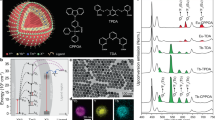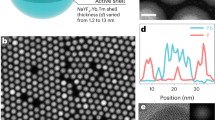Abstract
Thermal quenching, in which light emission experiences a loss with increasing temperature, broadly limits luminescent efficiency at higher temperature in optical materials, such as lighting phosphors1,2,3 and fluorescent probes4,5,6. Thermal quenching is commonly caused by the increased activity of phonons that leverages the non-radiative relaxation pathways. Here, we report a kind of heat-favourable phonons existing at the surface of lanthanide-doped upconversion nanomaterials to combat thermal quenching. It favours energy transfer from sensitizers to activators to pump up the intermediate excited-state upconversion process. We identify that the oxygen moiety chelating Yb3+ ions, [Yb···O], is the key underpinning this enhancement. We demonstrate an approximately 2,000-fold enhancement in blue emission for 9.7 nm Yb3+-Tm3+ co-doped nanoparticles at 453 K. This strategy not only provides a powerful solution to illuminate the dark layer of ultra-small upconversion nanoparticles, but also suggests a new pathway to build high-efficiency upconversion systems.
This is a preview of subscription content, access via your institution
Access options
Access Nature and 54 other Nature Portfolio journals
Get Nature+, our best-value online-access subscription
$29.99 / 30 days
cancel any time
Subscribe to this journal
Receive 12 print issues and online access
$209.00 per year
only $17.42 per issue
Buy this article
- Purchase on Springer Link
- Instant access to full article PDF
Prices may be subject to local taxes which are calculated during checkout




Similar content being viewed by others
References
Kim, Y. H. et al. A zero-thermal-quenching phosphor. Nat. Mater. 16, 543–550 (2017).
Wang, L. et al. Ca1–xLi x Al1–xSi1+xN3:Eu2+ solid solutions as broadband, color-tunable and thermally robust red phosphors for superior color rendition white light-emitting diodes. Light Sci. Appl. 5, e16155 (2016).
Zhu, H. et al. Highly efficient non-rare-earth red emitting phosphor for warm white light-emitting diodes. Nat. Commun. 5, 4312 (2014).
Liang, R. et al. A temperature sensor based on CdTe quantum dots-layered double hydroxide ultrathin films via layer-by-layer assembly. Chem. Commun. 49, 969–971 (2013).
Liu, D. et al. Emission stability and reversibility of upconversion nanocrystals. J. Mater. Chem. C 4, 9227–9234 (2016).
Zhu, X. et al. Temperature-feedback upconversion nanocomposite for accurate photothermal therapy at facile temperature. Nat. Commun. 7, 10437 (2016).
Auzel, F. & Chen, Y. The effective frequency in multiphonon processes: Differences for energy transfers or side-bands and non-radiative decay. J. Lumin. 66, 224–227 (1995).
Xue, X. et al. Size-dependent upconversion luminescence and quenching mechanism of LiYF4: Er3+/Yb3+ nanocrystals with oleate ligand adsorbed. Opt. Mater. Express 3, 989–999 (2013).
Lim, S. F., Ryu, W. S. & Austin, R. H. Particle size dependence of the dynamic photophysical properties of NaYF4: Yb, Er nanocrystals. Opt. Express 18, 2309–2316 (2010).
Liu, Y. et al. Amplified stimulated emission in upconversion nanoparticles for super-resolution nanoscopy. Nature 543, 229–233 (2017).
Gargas, D. J. et al. Engineering bright sub-10-nm upconverting nanocrystals for single-molecule imaging. Nat. Nanotech. 9, 300–305 (2014).
Brites, C. D. et al. Instantaneous ballistic velocity of suspended Brownian nanocrystals measured by upconversion nanothermometry. Nat. Nanotech. 11, 851–856 (2016).
Xu, J. et al. Near-infrared-triggered photodynamic therapy with multitasking upconversion nanoparticles in combination with checkpoint blockade for immunotherapy of colorectal cancer. ACS Nano 11, 4463–4474 (2017).
Wu, X. et al. Dye-sensitized core/active shell upconversion nanoparticles for optogenetics and bioimaging applications. ACS Nano 10, 1060–1066 (2016).
Zhao, J. et al. Single-nanocrystal sensitivity achieved by enhanced upconversion luminescence. Nat. Nanotech. 8, 729–734 (2013).
Lu, Y. et al. Tunable lifetime multiplexing using luminescent nanocrystals. Nat. Photon. 8, 32–36 (2014).
Zou, W. et al. Broadband dye-sensitized upconversion of near-infrared light. Nat. Photon. 6, 560–564 (2012).
Wang, F. et al. Simultaneous phase and size control of upconversion nanocrystals through lanthanide doping. Nature 463, 1061–1065 (2010).
Deng, R. et al. Temporal full-colour tuning through non-steady-state upconversion. Nat. Nanotech. 10, 237–242 (2015).
Wu, S., Ning, Y., Chang, J. & Zhang, S. Upconversion photoluminescence enhancement and modulation of NaYF4: Yb, Er through using different ligands. J. Lumin. 143, 492–497 (2013).
Bogdan, N., Vetrone, F., Ozin, G. A. & Capobianco, J. A. Synthesis of ligand-free colloidally stable water dispersible brightly luminescent lanthanide-doped upconverting nanoparticles. Nano Lett. 11, 835–840 (2011).
Shan, J., Uddi, M., Yao, N. & Ju, Y. Anomalous Raman scattering of colloidal Yb3+, Er3+ codoped NaYF4 nanophosphors and dynamic probing of the upconversion luminescence. Adv. Funct. Mater. 20, 3530–3537 (2010).
Panitz, J.-C., Mayor, J.-C., Grob, B. & Durisch, W. A Raman spectroscopic study of rare earth mixed oxides. J. Alloy Compd. 303, 340–344 (2000).
Levy, E. S. et al. Energy-looping nanoparticles: harnessing excited-state absorption for deep-tissue imaging. ACS Nano 10, 8423–8433 (2016).
Li, D., Shao, Q., Dong, Y. & Jiang, J. Anomalous temperature-dependent upconversion luminescence of small-sized NaYF4: Yb3+, Er3+ nanoparticles. J. Phys. Chem. C 118, 22807–22813 (2014).
Liu, G. et al. Confinement of electron–phonon interaction on luminescence dynamics in nanophosphors of Er3+: Y2O2S. J. Phys. Chem. B 171, 123–132 (2003).
Wang, F., Wang, J. & Liu, X. Direct evidence of a surface quenching effect on size-dependent luminescence of upconversion nanoparticles. Angew. Chem. Int Ed. Engl. 49, 7456–7460 (2010).
Vetrone, F. et al. Temperature sensing using fluorescent nanothermometers. ACS Nano 4, 3254–3258 (2010).
Lu, J. et al. One-step protein conjugation to upconversion nanoparticles. Anal. Chem. 87, 10406–10413 (2015).
Zheng, W. et al. Sub-10 nm lanthanide-doped CaF2 nanoprobes for time-resolved luminescent biodetection. Angew. Chem. Int Ed. 52, 6671–6676 (2013).
Zhao, J. et al. Upconversion luminescence with tunable lifetime in NaYF4:Yb,Er nanocrystals: role of nanocrystal size. Nanoscale 5, 944–952 (2013).
Liu, H. et al. Balancing power density based quantum yield characterization of upconverting nanoparticles for arbitrary excitation intensities. Nanoscale 5, 4770–4775 (2013).
Zhang, F. et al. Shape, size, and phase-controlled rare-earth fluoride nanocrystals with optical up-conversion properties. Chem. Eur. J. 15, 11010–11019 (2009).
Perdew, J. P., Burke, K. & Ernzerhof, M. Generalized gradient approximation made simple. Phys. Rev. Lett. 77, 3865–3868 (1996).
Blöchl, P. E. Projector augmented-wave method. Phys. Rev. B 50, 17953 (1994).
Kresse, G. & Furthmüller, J. Efficient iterative schemes for ab initio total-energy calculations using a plane-wave basis set. Phys. Rev. B 54, 11169–11186 (1996).
Liu, D. et al Three-dimensional controlled growth of monodisperse sub-50 nm heterogeneous nanocrystals. Nat. Commun. 7, 10254 (2016).
Acknowledgements
This project is primarily supported by the Australian Research Council (ARC) Discovery Early Career Researcher Award Scheme (J.Z., DE180100669), Chancellor’s Postdoctoral Fellowship Scheme at the University of Technology Sydney (J.Z.), and ARC Future Fellowship Scheme (D.J., FT 130100517).
Author information
Authors and Affiliations
Contributions
J.Z. and D.J. conceived the project and designed the experiments; S.W., J.L., and J.Z. conducted synthesis; C.C. and J.Z. performed the security ink printing and imaging; S.A.T. carried out simulation work; W.R. conducted the surface modification; C.M. and F.W. built the optical testing system; J.Z. conducted the spectroscopic characterization; J.Z. and D.J. prepared the figures, data analysis, supplementary information sections, and wrote the manuscript with input from other authors.
Corresponding authors
Ethics declarations
Competing interests
The authors declare no competing financial interests.
Additional information
Publisher’s note: Springer Nature remains neutral with regard to jurisdictional claims in published maps and institutional affiliations.
Supplementary information
Supplementary Information
Supplementary Data; Supplementary Figures 1–7; Supplementary Tables 1–2; Supplementary Reference 1.
Rights and permissions
About this article
Cite this article
Zhou, J., Wen, S., Liao, J. et al. Activation of the surface dark-layer to enhance upconversion in a thermal field. Nature Photon 12, 154–158 (2018). https://doi.org/10.1038/s41566-018-0108-5
Received:
Accepted:
Published:
Issue Date:
DOI: https://doi.org/10.1038/s41566-018-0108-5
This article is cited by
-
High-efficiency upconversion process in cobalt and neodymium doped graphene QDs for biomedical applications
Scientific Reports (2023)
-
Proof of crystal-field-perturbation-enhanced luminescence of lanthanide-doped nanocrystals through interstitial H+ doping
Nature Communications (2023)
-
Lanthanide-based ratiometric luminescence nanothermometry
Nano Research (2023)
-
Mastering lanthanide energy states for next-gen photonic innovation
Science China Chemistry (2023)
-
Super-resolution microscopy enabled by high-efficiency surface-migration emission depletion
Nature Communications (2022)



